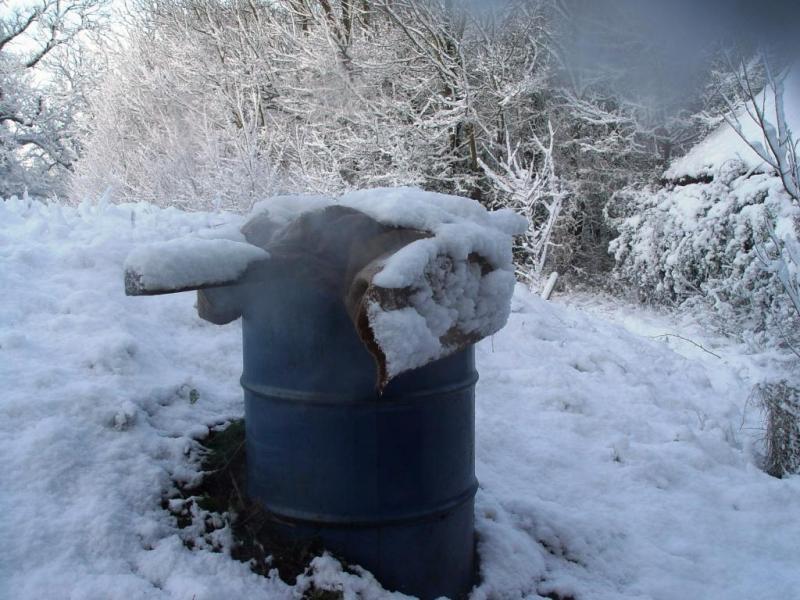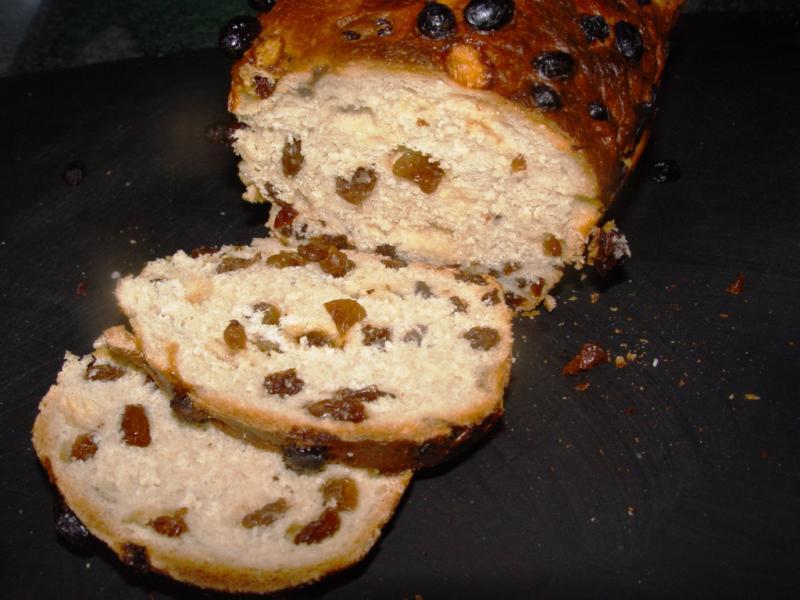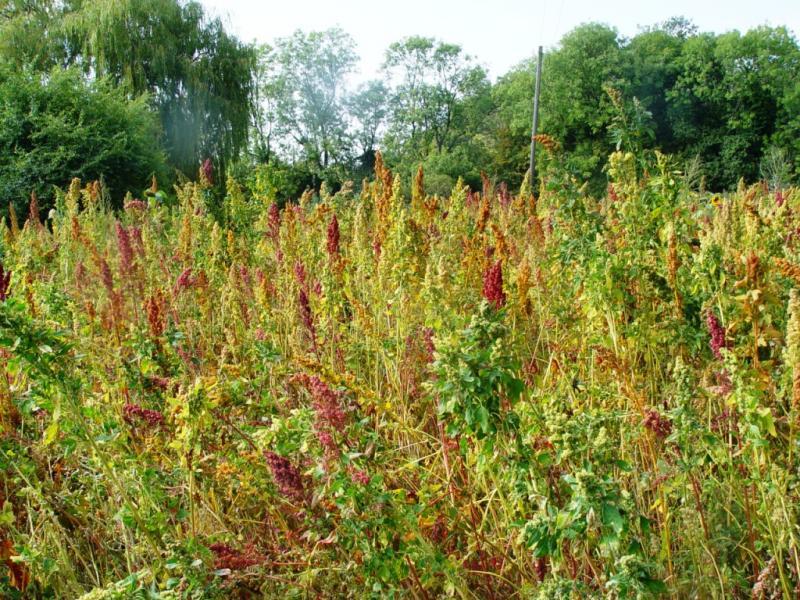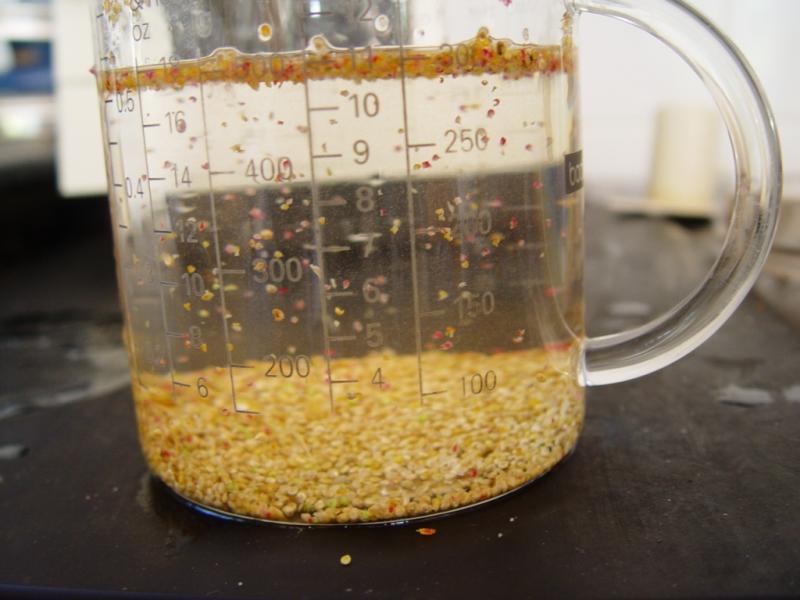
jackal10
participating member-
Posts
5,115 -
Joined
-
Last visited
Content Type
Profiles
Forums
Store
Help Articles
Everything posted by jackal10
-
Do you want to hot smoke/BBQ or cold smoke? For bacon, salmon, cheeses etc you need cold smoking - essentially a box with a seperate smoke generator seperated by enough distance or pipe to cool the smoke Here is my crude setup. It consists of an old (clean) oil drum with the top cut off. From a hole in the bottom a length (at least 6 foot) of drain pipe goes to a firebox lower down the mound (a brick lined hole in the ground with a roof tile for a roof ), in wich there is a pile of smoldering oak or fruit wood sawdust. The food is suspended or placed on racks in the drum. With this crude setup we smoked over a week just before the holidays 3 x 12kg (40lbs) hams - 120lbs in total, plus 6 sides of salmon, bacon, trout, cheeses (cheddar, stilton, brie, reblochon), quail eggs, and pretty much anything else we could find. Smoked mashed potato is delicous.
-
"The Cook and Housewife's manual: a Practical System of Modern Domestic Cookery and Family management; containing a Compendium of French Cookery and of Fashionable confectionary, preparations for invalids and convalescents, a Selection of Cheap Dishes"... Mistress Margaret Dods Orinally published about 1826, there were at least six editions up to 1864, and many copies are available online (eg www.bookfinder.com) There was a reprint in 1988 Meg Dods was the the innkeeper in Scott’s novel ST RONAN’S WELL but but she is said to have been modeled on Miss Marian Ritchie, the landlady of his local inn, the Cross Keys in Pebbles “The kitchen was her pride and glory; she looked to the dressing of every dish herself, and there were some with which she suffered no-one to interfere. Such were the cock-a-leeky, and the savoury minced collops……” ST. RONAN’S WELL was published in 1823, and such was the success of the figure of Meg Dods that three years later one of the earliest Scottish cookery books was published under her name. Tha actual author was Christian Isobel Johnston
-
$300 is fine for early adopters, libraries and collectors. Many small run professional books are similarly priced and much smaller, for example http://www.chipsbooks.com/bakprob.htm . Please put me down for one. However I hope there will also be an electronic/online edition. The repro costs of a DVD are much less, and the indexing better It would also allow for video and active media.
-
The original paper used "Instant Baker's yeast powder, produced specifically for bread making, purchased from Yung Chen Industry Ltd, Yaipei, Taiwan" I guess they mean http://www.yungcheng.com/big/product_detail.php?id=97 My example was just a demo.
-
I used instant mix ("fermipan" type) HOVIS Fast Action brand. The paper claims a 2.8x concentration increase of glycerol in the salt stressed yeast compared to the control, and quotes Hirasawa and Yokoigawa 2001 "Leavening ability of Bakers yeast exposed to hyperosmotic mediaq" FEMS Microbiol Lett 286:13-7 that suggests "a high correlation between intracellular glycerol accumulation and fermentation ability [in high sucrose concentrations]
-
I often have trouble getting very sweet doughs to rise, even with osmo tolerant yeast. According to http://www3.interscience.wiley.com/journal/122610047/abstract?CRETRY=1&SRETRY=0 stressing the yeast by soaking for 40 minutes in a 7% salt solution gives improved performance for sweet breads. As people are coming to tea, I though I would try - this formula is adapted from the experimental one in the paper by adding sultanas. I also used a different flour. It seemed to work well, alough I should have done a control. This is a very sweet bread, almost cake, with 24% (yes 24%) sugar 1. Rehydrate the yeast Yeast 2% 4g Water 0.5% 1g Sugar 0.5% 1g FLour 0.5% 1g Mix together and leave for 5 mins 2. Salt stress All the above Salt 1.5% 3g Water 17% 34g Leave for 40 mins at 25C 3. Main dough Flour 99.5% 199g (I used white spelt from http://www.glebe-flour.co.uk/ The dough was a bit slack so I added anther 100g) Milk powder 4% 8g Sugar 23.5% 47g (!) water 43% 86g Butter 4% 8g Sultanas 50% 100g Mix on high speed. Shape and pan. Proof in high humidity 30C (orgiginal forla said 38C) Egg wash and bake at 200C for 40 mins (I used 220C for 15 mins and 190C for 25 mins) Sweet breads bur easily..
-
Its not strongly flavoured, although nutritous and would behave a bit like rice or potato flour. It would change the bread texture, making the flour (and bread) softer I guess.
-
The taste was fairly neutral, similar to commercial quinoa, except the grain size was quite small. I should explain this as a bit of rough ground, with no fertiliser added. The grain was sown in May into a "stale seedbed" - the ground had been turned over in early spring, left for the annual weed to sprout which were then killed with glyphosate before sowing. I hand sacttered the seed and rough harrowed it. You can add cooked quinoa whole to bread as a texture. You can't make bread just from quinoa as it has no gluten. You can make pasta and pancake like flat breads
-
Try http://www.danlepard.com/forum/viewtopic.php?t=2454 I would look to your flour composition - maybe the sorgum. You need something that acts like gluten in ther in addition to the gums. Psyllium husk provides some of the magic.
-
This year I have treid growing Quinoa, th mother grain of the Aztecs http://en.wikipedia.org/wiki/Quinoa Actually this was part of a winter bird friendly ley mix, inlcuding sunflowers, buckwheat, tricale etc, but mostly quinoa. It grew surprsingly easily in ou UK East Anglian alkaline clay, withc colourful spectacular flower and seed heads. Its related to the weed Fat Hen, which also grows well here, and for a moment I thought that was what we had. Maybe next year I'll also add amaranth You can buy quinoa in health food stores, and it is a nutritous, high protein complete grain Experimentally I threshed a a couple of heads by putting them in the food processor and sieving the result I then floated off the remaining flower remains, and washed well. Quinoa is coated with a biter soap like saponin that must be washed off in warm water I then boiled the grain - you cook it like rice. Note the embryo stalk, which is characteristic. Delicous, nutty, with some texture. I'm surprised it is not more widely grown an used
-
Ideal apple for apple sauce Makes excellent apple juice as well
-
I'm not an expert at machine forming, but it sounds like the dough is not being rolled hard enough. Can you get the manufacturer to check the settings, in particular the spring tension on the forming plates and rollers? If you are on the BBGA mailing list http://finance.groups.yahoo.com/group/breadbakersguild/ there are some real experts there.
-
Amen Sam Leave it be in a warm place. It will recover
-
1. An immersion blender will not hurt your starters 2. Keep them in the fridge and refresh them only the day before you bake. Much less work.
-
Worcester sauce is the key. A good squeeze of tomato ketchup in the meat is good as well The leftover lamb joint, minced, with any leftover gravy Some softened onions mixed in. Personally I would omit carrots, peas, veg etc, and serve them seperately. Mashed potato on top, then browned Leftover shepards pie can be mixed all together with an egg, optionally breadcrumbed and shallow fried as rissoles.
-
Gordons changed its strength a few years ago in response to a duty increase . Has anyone tried a new artisanal small batch gin (and barley vodka) from http://www.sipsmith.com/ ? First new still in London making London Dry Gin for generations
-
Its the gluten that makes them stick. Dust your flipping board with rice flour every time.
-
Injecting oil and larding (or barding with bacon (mmm bacon)) while techniques to add fat and flavour do not compensate for poor meat or poor cooking technique. They deposit fat onto the outside of the muscle fibres, not inside, and do nothing to change tough stringy meat. They have additional dangers of potentially introducing pathogens into the realtively sterile interior of the meat. Marbling is an indication of good feeding and appropriate breed of beef. Its more than just the presence of fat. Good technique, good hanging, LTLT sous vide cooking (eg long time say 12 hours) at low temperature (say 55C) will do far more to imorove your meat than injecing oil.
-
I've tried blitzing it with icecubes, but it comes out grainy rather than smooth.
-
In a different but related question do you have a recipe for Leberkäse which contains, desipte the name, neither liver or cheese. I can't seem to get the texture right, despite keeping the mixture cold
-
I thought the main danger was not molds but the bacterium Clostridium botulinum, that can cause botulism. (botulus = latin for sausage). Keeping the sausage acid, either through ingredients like wine or vinegar, or from lactobacillus fermentation is a countermeasure. Myco toxins are rare, and like aflotoxin more common from cereal orign rather than meat.
-
He should worry more about the DHMO contamination in liquid pectins. http://www.dhmo.org/
-
I meant to add you may have noticed the characterisitic dark colour and fine bubbles in the crust of a long retarded dough (overnight in he fridge, for example before baking). The dark colour is due to extra sugars from breakdown of the surface starch and the fine blistering from gas exchange from CO2 to air in the suface cells
-
Crust chemistry is very complex. The egg white will give shinyness, and also amino acids for the Maillard reaction. I prefer not ice but water, but care of the burst of hot steam - shut the door fast. Polysaccharides are carbohydrates like starch that are complex molecules built from many sugar molecules joined together, not just higher order sugars http://en.wikipedia.org/wiki/Carbohydrate For Pumpernickel you can think of it as a long slow toasting or roasting, developing toasty flavours. rummages in old posts...here are some other crust treatments
-
Caramelisation is a different reaction to Maillard reaction. http://en.wikipedia.org/wiki/Maillard_reaction Maillard reactions need an amino acid, a reducing sugar and alkaline conditions. Caramelisation is oxidation of sugars http://en.wikipedia.org/wiki/Caramelization a different process. Hot steam in the first few minutes of a bake does indeed make a great crust. It gelatanises the surface starch, making more of it available for the other browning reactions. It mostly a mechanical rather than chemical reaction. Rye glutens are in the same family as wheat glutes, but less strong and stickier, so typical rye bread structure is more based on complex polysaccharides, including rye starch and pentosans.








